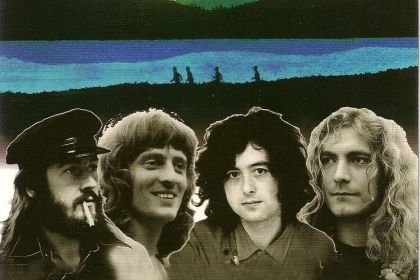Music Theory
The Doors songs with Aeolian and harmonic minor modes

The Doors' Bring Out Your Dead LP
Known since the Baroque era, the homophonic texture remains the most convenient songwriting technique based on the harmonious interaction between the vocal melody and chord accompaniment. To compose chord progressions that make the arrangement digestible, songwriters often utilize six diatonic modes postulated in the modern tonal theory: the Ionian, Aeolian, Dorian, Phrygian, Lydian, and Mixolydian.
In general, The Doors' musical output is not overly burdened with classical canons as only a third of their 59 studio tracks—recorded with frontman Jim Morrison—are written using the tonal theory. The harmonic analysis of these 21 songs shows the dominance of the Ionian and Aeolian modes—a standard choice of many classical and popular music composers.
Either way, the Aeolian mode appears in nine of The Doors songs whose harmonic analysis is given below. Learn about the structure of this musical mode in our article covering 8 songs to introduce Aeolian mode and natural minor scale.
A good example of an uncomplicated but dynamic chord progression written in the Aeolian scale is found in Unhappy Girl. In the harmonic analysis of the song chord chains, the scale degrees (denoted with Roman numerals) show the following progression in C Aeolian: Cm–B♭ or i–VII. It accompanies all song sections except for the chorus.
Such a combination of two triads rooted in the first and seventh scale degrees provides a certain harmonic pulsation not only in the Aeolian but in the Dorian mode, which has the same structure of tonic and subtonic chords. This two-chord succession can be found in a variety of songs including Simon & Garfunkel's Scarborough Fair, The Beatles' And I Love Her and Don’t Bother Me.
The Doors' Shaman's Blues is mainly built on a powerful riff formed by tonic and subtonic chords as you can see from our article on how a quintessential The Doors song refined their most controversial album. Break On Through and Five to One, mentioned in our article on the Dorian mode in The Doors songs, are accompanied exclusively by the same i–VII two-chord sequence. Because of this, both songs can be equally attributed to either Aeolian or Dorian modes.
The Unhappy Girl chorus uses a three-chord progression for the backdrop: Gm–Fm–Cm or v–iv–i. Note that the song helps to understand the concept of the harmonic sequence—a musical turnaround repeated in a modified form involving different scale degrees. Here the segment of the sequence is formed by two chords i–VII whose roots are spaced from each other by a major second. This segment is repeated starting from the fifth (v–iv) scale degree and involving two minor triads of the Aeolian mode.
Listen to Unhappy Girl (2017 Remaster) by The Doors:
An excellent example of well-developed progressions involving all the chords of Aeolian mode (except for the diminished supertonic chor) is given in Riders on the Storm where all verses and the first solo are accompanied by the following chord chains:
- Em–G–Em–G–Em or i–III–i–III–i;
- Am–Bm–C–D–Em–G–Em or iv–v–VI–VII–i–III–i;
- Em–D–C–Em–G–Em or i–VII–VI–i–III–i.
The remaining song sections (intro, outro, and second solo) are accompanied by two musical riffs:
- Em–G–Em or i–III–i;
- Em–D–Em or i–VII–i.
It is necessary to highlight the Am–Bm–C–D–Em progression in which the chords are built sequentially in each scale degree from the fourth to the first, thereby creating a noticeable harmonic accent that separates the phrases "into this house we're born" and "into this world we're thrown".
Listen to Riders on the Storm (Official Audio) by The Doors:
The obvious drawback of the Aeolian mode is the impossibility of using a perfect authentic cadence. As a result, the ending of musical phrases with the v–i turnaround does not impress with its completeness. To avoid such harmonic inconveniences in the Aeolian mode, composers usually apply the V major dominant chord instead of the minor one, thus introducing the harmonic minor scale.
An example of this swap can be found in People Are Strange accompanied by the following progressions in E Aeolian:
- Em–Am–Em–Am–Em–B7–Em or i–iv–i–iv–i–V7–i for verses and keyboard solo;
- B7–G–B7 or V7–III–V7 for choruses.
The first progression shows a rather typical pop music combination of plagal (iv–i) and authentic (V7–i) cadences, with the latter introducing the B7 major dominant seventh chord. The chord contains a leading-tone borrowed from the harmonic minor scale. The same major dominant seventh chord rooted in the fifth scale degree appears in the second progression.
Listen to People Are Strange (New Stereo Mix) by The Doors:
Another Aeolian and harmonic minor combination manifests itself in Take It as It Comes in the intro and first verse where the progression is written in the key of E minor: Em–G–D–Em or i–III–VII–i.
In other song sections, the key is switched to A minor, which is a case of tonicization of the fourth scale degree: Am–F–E–E7 or i–VI–V–V7. Here, the E7 dominant seventh chord ends the progression to form a half authentic cadence.
Listen to Take It as It Comes (2017 Remaster) by The Doors:
Once again, the major dominant chord can be observed in Spanish Caravan whose guitar solo was definitely inspired by the highly ornamented passages of the classical piano piece Asturias composed by Isaac Albéniz in the spirit of flamenco music.
Each line of the quatrain is accompanied by the chord chain: Em–Am–B7–Em or i–iv–V7–i. This harmonic turnaround is considered to be one of the most powerful classical music cadences used to complete musical forms.
Equally interesting is the chord progression that appears in the reprise with the lyrics "Take me, Spanish Caravan. Yes, I know you can": Em–D–C–B or i–VII–VI–V. Notice the sense of finality created by the B major dominant chord played on the acoustic guitar after Morrison finishes the reprise.
Curiously, the i–VII–VI–V musical turnaround is referred to as the Andalusian cadence and is the core of the flamenco genre. This highly recognizable sequence accompanies many pop songs including Bob Dylan's One More Cup of Coffee (Valley Below), Dire Straits' Sultans of Swing, Tom Waits' Ice Cream Man, Michael Jackson's Smooth Criminal, and Percy Mayfield's Hit the Road Jack. Harmonic analyses for the listed tracks are outlined in our article on the distinct chord progression of flamenco that captivated all pop music genres.
Listen to Spanish Caravan (2018 Remaster) by The Doors:
Finally, a slightly altered Aeolian mode is found in Maggie M'Gill whose harmonic analysis is detailed in our article on the Dorian mode in The Doors songs.
Explore how The Doors uses other musical modes:
- Mixolydian mode in The Doors songs
- Dorian mode in The Doors songs
- Peace Frog: the only Doors song featuring Lydian mode
Discover more songs composed in Aeolian minor mode and check out their harmonic analysis in the following articles:
- 8 songs to introduce Aeolian mode and natural minor scale
- 6 songs combining harmonic minor and Aeolian mode
- Beatles songs with harmonic minor and Aeolian modes
- Butterflies and Hurricanes: piano intermezzo meets the chaos theory
- Hero and Heroine: Strawbs lyrics that allegorize drug addiction through Greek mythology
- Bungle in the Jungle: early prog-rock hit vs the greatest boxing match
- Golden Slumbers: lyrical origins of the famous Beatles lullaby
- Hypnotized: Fleetwood Mac's song about aliens
- I Shot the Sheriff: Burnin' spliff nearly destroyed Bob Marley's original recording



